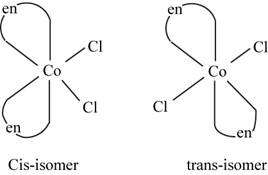
(a)
To determine: The experiment to confirm the formation of
(a)
Answer to Problem 1DE
Solution: The reaction of the given product with
Explanation of Solution
The reaction of the given coordination compound with the solution of
Whereas, if the compound formed is
This will confirm the formation of desired product.
The reaction of the given product with
(b)
To determine: If the cobalt present in the given reaction is in
(b)
Answer to Problem 1DE
Solution: The oxidation state of cobalt is
Explanation of Solution
The oxidation state of cobalt in
Substitute the values of oxidation state of ethylene diammine, chlorine and the total charge on the molecule in the above equation,
Therefore, the oxidation state of cobalt in
The electronic configuration of
The ethylene diammine present in the given complex is a strong field ligand which causes pairing of electrons in metal ions.

Figure 1
Since, there is no unpaired electron present in the given complex. Therefore, the spin state of the cobalt is zero in the given complex.
The oxidation state of cobalt is
(c)
To determine: The existence of geometrical isomerism in the complex
(c)
Answer to Problem 1DE
Solution: The geometrical isomerism exists in the given complex and the isomers are of different colors which confirm their presence in the mixture.
Explanation of Solution
The geometrical isomerism is the isomerism in which the structure and molecular formula of the molecule is same but the orientation of groups around the metal atoms changes.
The molecule
The geometrical isomers of the

Figure 2
The isomers of
The geometrical isomerism exists in the given complex and the isomers are of different colors which confirm their presence in the mixture.
(d)
To determine: The way to know the isomer which is formed as a product in the given reaction out of the two isomers.
(d)
Answer to Problem 1DE
Solution: The color of trans isomer is green and of cis isomer is violet which gives the confirmation of the geometry of product.
Explanation of Solution
The color of cis isomer of
The color of trans isomer is green and of cis isomer is violet which gives the confirmation of the geometry of product.
Want to see more full solutions like this?
Chapter 23 Solutions
MAST F/ CHEM: THE CENTRAL SCI CODE ALON
- Highlight the chirality (or stereogenic) center(s) in the given compound. A compound may have one or more stereogenic centers. OH OH OH OH OH OHarrow_forwardUsing wedge-and-dash bonds, modify the bonds on the chiral carbon in the molecule below so the molecule has R stereochemical configuration. NH H Br X टेarrow_forwardProvide photos of models of the following molecules. (Include a key for identification of the atoms) 1,2-dichloropropane 2,3,3-trimethylhexane 2-bromo-3-methybutanearrow_forward
- Please draw the structure in the box that is consistent with all the spectral data and alphabetically label all of the equivalent protons in the structure (Ha, Hb, Hc....) in order to assign all the proton NMR peaks. The integrations are computer generated and approximate the number of equivalent protons. Molecular formula: C13H1802 14 13 12 11 10 11 (ppm) Structure with assigned H peaks 2.08 3.13arrow_forwardA 0.10 M solution of acetic acid (CH3COOH, Ka = 1.8 x 10^-5) is titrated with a 0.0250 M solution of magnesium hydroxide (Mg(OH)2). If 10.0 mL of the acid solution is titrated with 10.0 mL of the base solution, what is the pH of the resulting solution?arrow_forwardFirefly luciferin exhibits three rings. Identify which of the rings are aromatic. Identify which lone pairs are involved in establishing aromaticity. The lone pairs are labeled A-D below.arrow_forward
- A 0.10 M solution of acetic acid (CH3COOH, Ka = 1.8 x 10^-5) is titrated with a 0.0250 M solution of magnesium hydroxide (Mg(OH)2). If 10.0 mL of the acid solution is titrated with 10.0 mL of the base solution, what is the pH of the resulting solution?arrow_forwardGiven a complex reaction with rate equation v = k1[A] + k2[A]2, what is the overall reaction order?arrow_forwardPlease draw the structure in the box that is consistent with all the spectral data and alphabetically label all of the equivalent protons in the structure (Ha, Hb, Hc....) in order to assign all the proton NMR peaks. The integrations are computer generated and approximate the number of equivalent protons. Molecular formula: C13H1802 14 13 12 11 10 11 (ppm) Structure with assigned H peaks 2.08 3.13arrow_forward
- CHEMICAL KINETICS. One of the approximation methods for solving the rate equation is the steady-state approximation method. Explain what it consists of.arrow_forwardCHEMICAL KINETICS. One of the approximation methods for solving the rate equation is the limiting or determining step approximation method. Explain what it consists of.arrow_forwardCHEMICAL KINETICS. Indicate the approximation methods for solving the rate equation.arrow_forward
 ChemistryChemistryISBN:9781305957404Author:Steven S. Zumdahl, Susan A. Zumdahl, Donald J. DeCostePublisher:Cengage Learning
ChemistryChemistryISBN:9781305957404Author:Steven S. Zumdahl, Susan A. Zumdahl, Donald J. DeCostePublisher:Cengage Learning ChemistryChemistryISBN:9781259911156Author:Raymond Chang Dr., Jason Overby ProfessorPublisher:McGraw-Hill Education
ChemistryChemistryISBN:9781259911156Author:Raymond Chang Dr., Jason Overby ProfessorPublisher:McGraw-Hill Education Principles of Instrumental AnalysisChemistryISBN:9781305577213Author:Douglas A. Skoog, F. James Holler, Stanley R. CrouchPublisher:Cengage Learning
Principles of Instrumental AnalysisChemistryISBN:9781305577213Author:Douglas A. Skoog, F. James Holler, Stanley R. CrouchPublisher:Cengage Learning Organic ChemistryChemistryISBN:9780078021558Author:Janice Gorzynski Smith Dr.Publisher:McGraw-Hill Education
Organic ChemistryChemistryISBN:9780078021558Author:Janice Gorzynski Smith Dr.Publisher:McGraw-Hill Education Chemistry: Principles and ReactionsChemistryISBN:9781305079373Author:William L. Masterton, Cecile N. HurleyPublisher:Cengage Learning
Chemistry: Principles and ReactionsChemistryISBN:9781305079373Author:William L. Masterton, Cecile N. HurleyPublisher:Cengage Learning Elementary Principles of Chemical Processes, Bind...ChemistryISBN:9781118431221Author:Richard M. Felder, Ronald W. Rousseau, Lisa G. BullardPublisher:WILEY
Elementary Principles of Chemical Processes, Bind...ChemistryISBN:9781118431221Author:Richard M. Felder, Ronald W. Rousseau, Lisa G. BullardPublisher:WILEY





